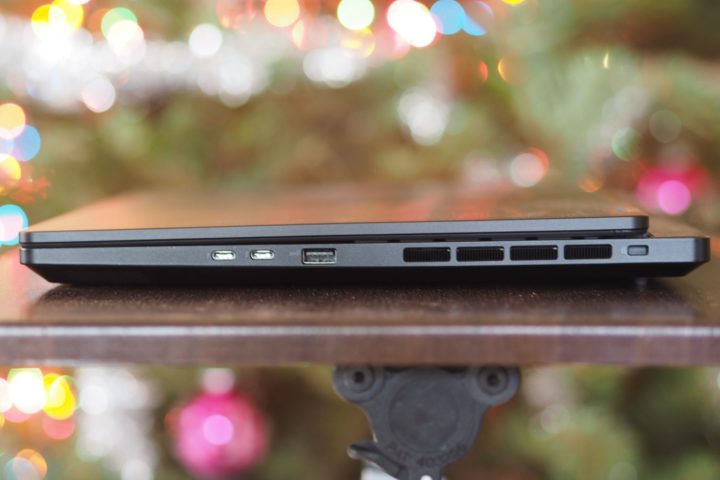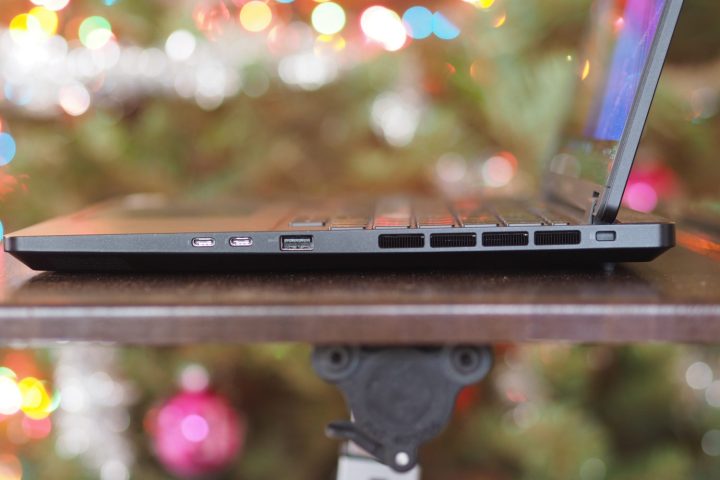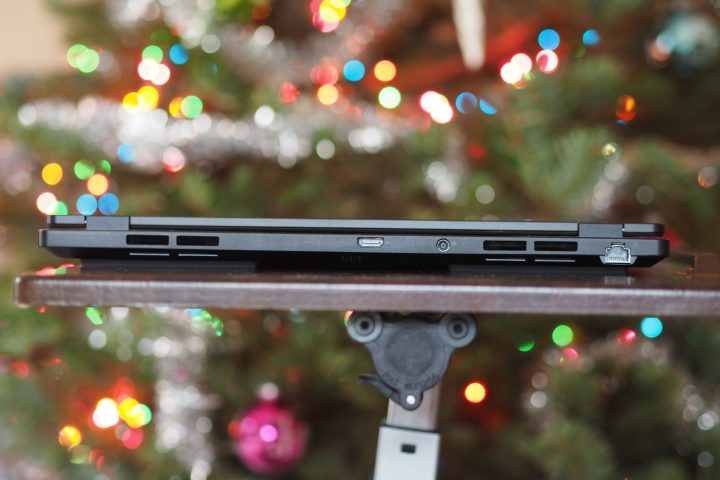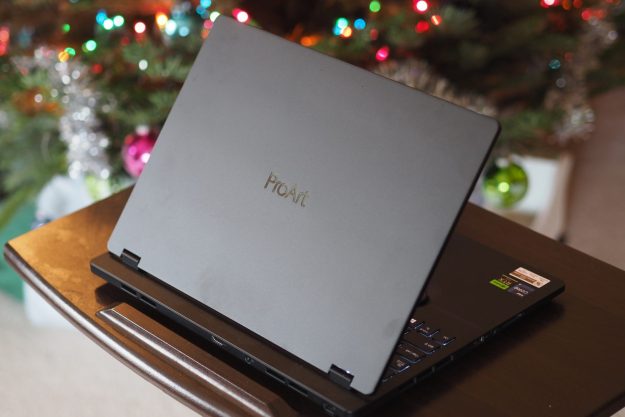
- Solid creativity performance
- Good 1080p gaming performance
- Useful Asus Dial
- Excellent OLED display
- Responsive haptic touchpad
- Expensive
- Poor battery life
- Touchpad position is odd
The 16-inch laptop, specifically when aimed at speeding up and enhancing video editing, has become important to creators and manufacturers alike. Fast CPUs and GPUs and color-accurate displays are their calling cards, and the Asus ProArt Studiobook 16 OLED is equipped to offer all three.
It’s a competitive market, though, with several excellent entries, including the class-leading MacBook Pro. The ProArt Studio 16 OLED might not be a standout in every way, but it does just enough to warrant a recommendation, with solid performance, an excellent build, and a few unique features you won’t find anywhere else.
Specs and configurations
| Asus ProArt Studiobook 16 OLED | |
| Dimensions | 14.02 inches x 10.67 inches x 0.82-0.94 inches |
| Weight | 5.29 pounds |
| Processor | Intel Core i9-13980HX |
| Graphics | Nvidia GeForce RTX 4060 Nvidia GeForce RTX 4070 Nvidia RTX 3000 Ada |
| RAM | 16GB DDR5 32GB DDR5 64GB DDR5 |
| Display | 16.0-inch 16:10 3.2K (3200 x 2000) OLED, 120Hz |
| Storage | 1TB SSD |
| Touch | Yes |
| Ports | 2 x USB-C with Thunderbolt 4 2 x USB-A 3.2 Gen 1 1 x HDMI 2.1 1 x 2.5GB Ethernet 1 x microSD card reader 1 x 3.5mm audio jack 1 x nanoSIM card reader (optional) |
| Wireless | Wi-Fi 6E and Bluetooth 5.2 |
| Webcam | 1080p with infrared camera for Windows 11 Hello |
| Operating system | Windows 11 |
| Battery | 90 watt-hour |
| Price | $2,000+ |
The ProArt Studiobook 16 OLED starts at $2,000 for an Intel Core i9-19380HX CPU, 16GB of RAM, a 1TB SSD, an Nvidia GeForce RTX 4060 GPU, and a 16-inch OLED display. The review unit was the high-end configuration, priced at $3,000, with 64GB of RAM, a 2TB SSD, and an Nvidia RTX 3000 Ada GPU.
That makes the laptop a premium machine but not overly expensive for a portable creator’s workstation. For example, a similarly configured Dell XPS 17 is considerably more expensive at $3,749.
A laptop made for creators
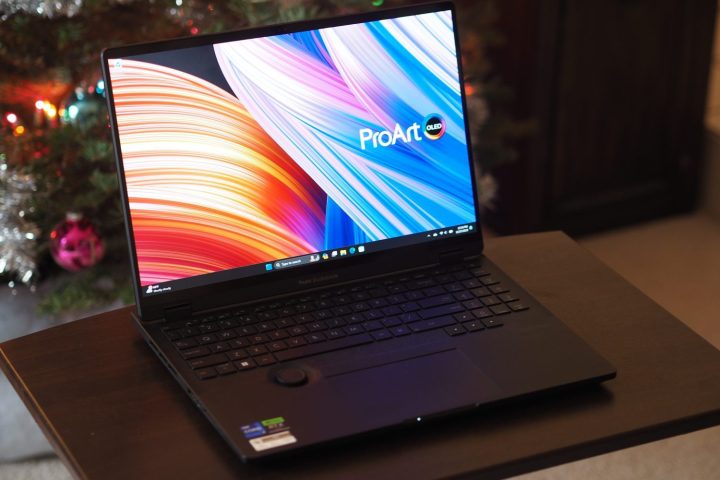
The ProArt Studiobook 16 OLED is a large laptop thanks to a chassis that extends beyond the display. Compared to the Dell XPS 17, it’s almost an inch deeper despite having a smaller display, and it’s quite a bit thicker at up to 0.94 inches compared to the XPS 17’s 0.77 inches. It’s not terribly heavy for a large laptop at 5.29 pounds, but that’s still a pound heavier than the Dell XPS 15.
The all-aluminum Studiobook is built like a tank, just as rigid in its lid and chassis as the standard for great build quality, Apple’s MacBook Pro. Unsurprisingly, given the heavy chassis, the hinge opens with one hand and remains in place while working with just the tiniest wobble. The Studiobook feels like a premium laptop and one that’s built for serious work. Asus has applied its antimicrobial coating to the keyboard, palm rest, and touchpad, which kills 99% of bacteria. Anyone concerned about avoiding bacterial infection can take heart but note that the coating does nothing to protect against viruses like COVID-19.
The Studiobook’s aesthetic is more laid back, with a solid black color scheme and a simple embossed ProArt logo on the lid. The palm rest and keyboard deck blend in together, and just some status lights in a notch cut into the palm rest add anything to break it up. Or, it would if not for the Intel, Nvidia, and Asus logo badges on the lower left, which I hate to see on such an expensive laptop. The Asus Dial set below the keyboard on the left side adds a bit of futurism to an otherwise basic design.
Speaking of the Asus Dial, that’s a peripheral that looks just like it sounds, a dial that’s pressed down to activate various functionality based on which apps are in the foreground. When it’s just Windows, the Dial allows changing brightness and volume.
When apps like those in Adobe’s Creative Suite are front and center, the Dial provides a wider variety of functionality, such as changing brush size, zooming, changing brightness and contrast, and more. In addition, the Dial mimics the Microsoft Wheel and can be controlled using the Microsoft Wheel settings page. More generally, the Dial is controlled with the ProArt Creator Hub utility, just one of several apps bundled with the Studiobook.
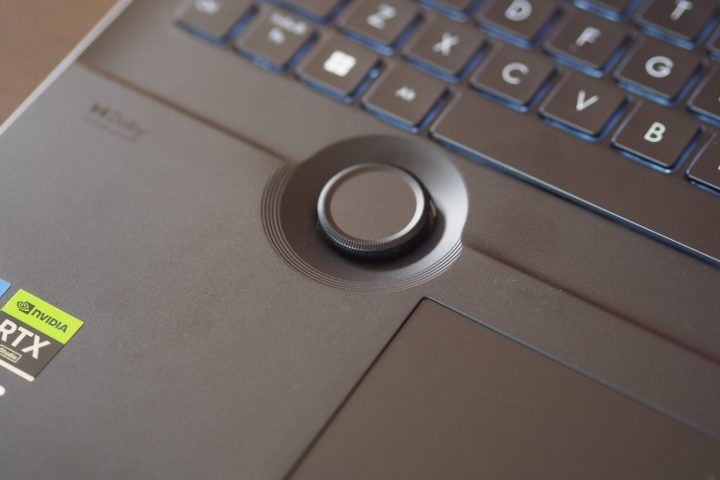
The Dial works well, but its placement highlights a design flaw. It’s just above the top left-hand corner of the touchpad, which pushes the touchpad well to the right of the spacebar. On a laptop with a number pad, the touchpad is usually moved underneath the spacebar so that your palms aren’t constantly resting on it while typing.
Putting your fingers comfortably on the home row requires rubbing against the touchpad with your right palm (which exhibited excellent palm detection during my testing). That’s hard to get used to, and I was never fully comfortable with the touchpad being so far out of position.

The keyboard was very good otherwise, with plenty of key spacing while accommodating a numeric keypad. The deep switches were tight and springy, with a light and snappy touch that I found quite precise and didn’t cause any fatigue as I wrote this review. The haptic touchpad isn’t as large as it could be, another casualty of the Dial’s placement, but it worked well with quick and responsive haptic clicks. Apple’s Force Touch haptic touchpad is much larger on the 16-inch MacBook Pro, but otherwise, I couldn’t tell the difference between their performance.
Notably, the touchpad supports the Asus Active Pen 2, providing an accurate albeit small drawing and writing tablet. The display also supports the pen, but that’s a much less natural inking surface.
The Studiobook’s generous connectivity is intelligently placed, with the most-used ports on the sides and the less-used connections on the back. The latter includes the Ethernet port and the proprietary power connector that mates with a large, heavy power brick. Wireless connectivity is up to date.
Finally, the webcam is a 1080p version that provides an excellent image for videoconferencing and several features, such as 3D noise reduction technology, that enhance the final image. There’s an infrared camera for Windows 11 Hello facial recognition, which worked quickly and accurately. If you prefer to use a fingerprint reader, there’s one integrated into the power button.
The performance is good enough for all but the most demanding creators
A 55-watt Intel Core i9-13980HX powers the ProArt Studiobook 16 OLED. That’s the fastest Raptor Lake CPU you can get for a laptop, with 24 cores (eight Performance and 16 Efficiency) and 32 threads, running at up to 5.6GHz. It’s generally an excellent performer, and Asus has gotten the most out of it thanks to a carefully crafted thermal solution, including liquid metal and dual 102-blade fans.
In each of our CPU-intensive benchmarks, the Studiobook kept up with the Lenovo Legion 9i, a fast gaming laptop. The Studiobook was significantly faster than the rest of our comparison group and is overkill for even the most demanding productivity workflows.
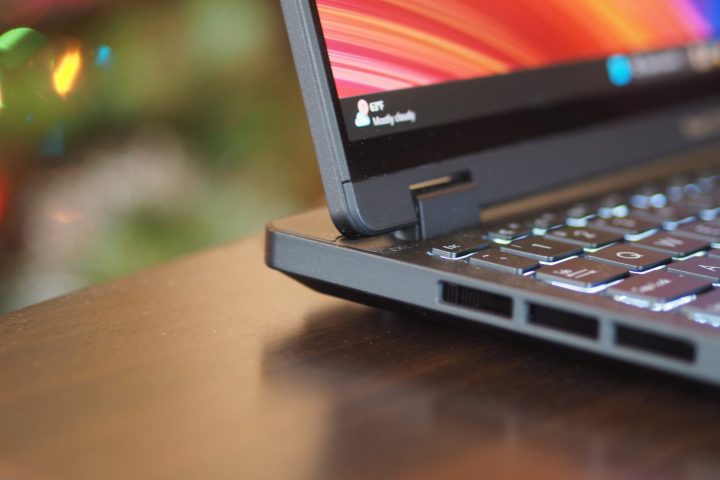
The Studiobook is meant to shine in creative applications, though, where the GPU plays an important role. My review unit came with the Nvidia RTX 3000 Ada GPU running Nvidia’s Studio drivers, both optimized for the best performance and reliability in creative, scientific, and engineering applications. That chip is roughly equivalent to the GeForce RTX 4070, and by that standard, it scored well in the Pugetbench for Premiere Pro benchmark. This is an important test because it shows how the laptop performs in a real-world application that stresses both the CPU and the GPU. Compared to the MacBook Pro with Apple’s latest M3 Max and most Windows laptops with more powerful GPUs, the Studiobook isn’t quite as fast.
Overall, the ProArt Studiobook 16 OLED is fast enough to meet the needs of all but the most demanding professional creators. Those users will be willing to spend more money for the fastest performance; for everyone else, the Studiobook is more than fast enough.
| Geekbench 6 (single/multi) |
Handbrake (seconds) |
Cinebench R23 (single/multi) |
Pugetbench Premiere Pro |
|
| Asus ProArt Studiobook 16 OLED (Core i9-13980HX / RTX 3000 Ada) |
Bal: 2,312 / 16,034 Perf: 2,312 / 16,075 |
Bal: 50 Perf: 49 |
Bal: 1,713 / 22,271 Perf: 1,617 / 26,487 |
Bal: 693 Perf: 697 |
| MSI Prestige 16 Studio (Core i7-13700H / RTX 4060) |
Bal: 1,880 / 6,951 Perf: 1,903 / 11,945 |
Bal: 139 Perf: 80 |
Bal: 1,797 / 7,959 Perf: 1,921 / 13,647 |
Bal: 460 Perf: 521 |
| Lenovo ThinkPad P1 Gen 6 (Core i7-13800H / RTX 4080) |
Bal: 2,562 / 12,146 Perf: 2,660 / 12,301 |
Bal: 75 Perf: 72 |
Bal: 1,942 / 15,248 Perf: 1,991 / 15,219 |
Bal: 595 Perf: 683 |
| Dell XPS 17 (9730) (Core i7-13700H / RTX 4070) |
Bal: 2,582 / 12,953 Perf: 2,579 / 13,037 |
Bal: 79 Perf: 71 |
Bal: 1,913 / 13,384 Perf: 1,912 / 15462 |
Bal: 568 Perf: 615 |
| HP Envy 16 2023 (Core i9-13900H / RTX 4060) |
Bal: 1,997 / 12,742 Perf: 1,992 / 12,645 |
Bal: 73 Perf: 75 |
Bal: 1,944 / 15,596 Perf: 1,954 / 15,422 |
Bal: 644 Perf: 608 |
| Lenovo Legion 9i (Core i9-13980HX / RTX 4090) |
Bal: 2,959 / 17,367 Perf: N/A |
N/A | Bal: 2,041 / 27,301 Perf: N/A |
Bal: 838 Perf: N/A |
| Apple MacBook Pro 14 (M3 Max 16/40) |
Bal: 3,714 / 21,137 Perf: N/A |
Bal: 53 Perf: N/A |
Bal: 1,881 / 22,028 Perf: 1,883 / 23,417 |
Bal: 885 Perf: N/A |
The Studiobook isn’t aimed at gamers, but it has a reasonably fast GPU that can accommodate modern titles at 1080p and even 1440p with the right settings. As mentioned above, the RTX 3000 Ada is roughly equivalent to the GeForce RTX 4070, and it performed accordingly in our suite of gaming benchmarks.
It was faster than the HP Omen 16, a dedicated gaming machine with an RTX 4070, and it was competitive with the Lenovo ThinkPad P1 Gen 6 with an RTX 4080. Neither the RTX 3000 Ada nor Nvidia’s Studio drivers provide optimal gaming performance, making these results pretty impressive. If you want to do some gaming to go with your serious work, the ProArt Studiobook 16 OLED will deliver.
| 3DMark Time Spy | Assassin’s Creed Valhalla (1080p Ultra High) |
Cyberpunk 2077 (1080p Ultra) |
Civilization 6 (1080p Ultra) |
|
| Asus ProArt Studiobook 16 OLE (RTX 3000 Ada) |
Bal: 11,966 Perf: 13,141 |
Bal: 115 fps Perf: 118 fps |
Bal: 80 fps Perf: 104 fps |
Bal: 114 fps Per: 113 fps |
| HP Omen 16 (RTX 4070) |
Bal: 11,380 Perf: 12,037 |
Bal: 100 fps Perf: 103 fps |
Bal: 74 fps Perf: 84 fps |
N/A |
| Lenovo ThinkPad P1 Gen 6 (RTX 4080) |
Bal: 9,806 Perf: 13,615 |
Bal: 71 fps Perf: 30 fps |
Bal: 67 fps Perf: 105 fps |
Bal: 160 fps Perf: 198 fps |
| Lenovo Legion Pro 7i (RTX 4080) |
Bal: 12,874 Perf: 18,017 |
Bal: 125 Perf: 129 fps |
Bal: 114 fps Perf: 113 fps |
Bal: 217 fps Perf: 219 fps |
| MSI GT77 Titan 2023 (RTX 4090) |
Bal: 20,836 Perf: N/A |
Bal: 150.9 fps Perf: N/A |
Bal: 132.7 fps Perf: N/A |
N/A |
The Studiobook has a 90-watt-hour battery, less than some 16-inch laptops with 100-watt-hours. But even with a larger battery, the laptop wouldn’t have lasted long with its large OLED display and power-hungry components.
It managed just 4.5 hours in our web browsing test and 6.25 hours looping our test video. This is around half the overall laptop average in both tests and is typical for this class of machines, with the Dell XPS 17 hitting around the same numbers. If you plan to do any real work, take the large and heavy charger with you.
OLED’s usual colors and contrast
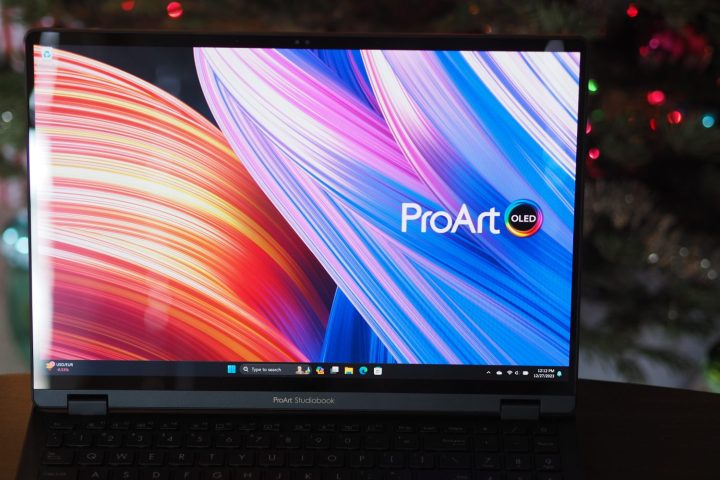
Asus has been a leader in choosing OLED displays across its range of laptops, and it’s no surprise that it chose the same technology for the ProArt Studiobook 16 OLED. While OLED panels are best known for their deep contrast and inky blacks, they’re also great for creators thanks to typically wide and accurate colors.
The Studiobook’s display is no different. It was spectacular out of the box, and my colorimeter agreed. It hit 100% of the sRGB color gamut, 97% of AdobeRGB, and 99% of DCI-P3, with an accuracy of DeltaE 1.06 (1.0 or less is considered excellent). Its blacks were perfect, and it managed 327 nits of brightness.
All of these numbers point to a display that will delight even the most demanding creators, and it will also make media consumers happy.
The audio quality was just okay, with two upward-firing speakers providing just enough volume to fill my small home office. It’s surprising that Asus didn’t add more speakers, given all the space available in the large chassis. As it is, the Studiobook can’t compete with the Dell XPS 15 or MacBook Pro 16, both of which pump out excellent sound.
A solid entry in the creative space
The ProArt Studiobook 16 OLED is just fast enough to compete as a creator’s workstation, and it’s a decent gaming machine for those who want their laptop to do double duty. It’s very well built and enjoys an excellent OLED display.
Asus is banking on extra features like the Asus Dial and the excellent haptic touchpad to differentiate from the norm. Do your shopping first — and make sure you really don’t want a MacBook Pro, of course. It has some significant advantages over the Studiobook 16, most notably in battery life, fan noise, and speakers.
But not everyone wants to switch to a Mac, of course. So, while the shortcomings of the ProArt Studiobook show how far ahead Apple is, it has enough good things going to warrant a recommendation for Windows-based creators.
Editors' Recommendations
- The XPS 16 is fighting an uphill battle against the MacBook Pro
- The HP Envy 16 costs less, but the mighty MacBook Pro 16 retains its top spot
- This powerhouse laptop gives the MacBook Pro an honest run for its money
- The new Asus Zenbook S 13 is like a MacBook, only better
- Hoping for an OLED MacBook Pro? We’ve got some bad news

